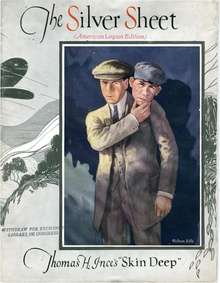House organ

A house organ (also variously known as an in-house magazine, in-house publication, house journal, shop paper, plant paper, or employee magazine) is a magazine or periodical published by a company or organization for its customers, employees, union members, parishioners, political party members, and so forth.[1] This name derives from the use of "organ" as referring to a periodical for a special interest group.
House organs typically come in two types, internal and external. An internal house organ is meant for consumption by the employees of the company as a channel of communication for the management. An external house organ is meant for consumption by the customers of the company, and may be either a free regular newsletter, or an actual commercial product in its own right.
An example of a commercial house organ is the Avalon Hill General. This had no outside advertising (usually a major portion of a magazine's budget). It featured news, strategy articles, variants, and essays on game design—all about Avalon Hill games.[2]
References
- ↑ Cambridge Dictionary : House organ
- ↑ Peter P. Perla (January 1990). The art of wargaming. ISBN 9780870210501
Further reading
- Employee magazines in the United States. Studies in industrial relations problems. 110. National Industrial Conference Board. 1925.
- Shel Holtz (2004). "Types of Employee Communications". Corporate conversations: a guide to crafting effective and appropriate internal communications. AMACOM Div American Mgmt Assn. pp. 84&ndash, 86. ISBN 978-0-8144-0770-7.
- Hayes, Elinor (November 1922). "The Employees' Publication". University Journal of Business. The University of Chicago Press. 1 (1): 81–94. doi:10.1086/506641. JSTOR 2354751.
- Peter Francis O'Shea (1920). Employees' Magazines for Factories, Offices, and Business Organizations. H. W. Wilson Company.
- JoAnne Yates (1993). Control through communication: the rise of system in American management. Studies in Industry and Society. 6. JHU Press. pp. 17, 74&ndash, 77. ISBN 978-0-8018-4613-7.
- Elspeth H. Brown (2008). The Corporate Eye: Photography and the Rationalization of American Commercial Culture, 1884–1929. JHU Press. pp. 137&ndash, 143. ISBN 978-0-8018-8970-7.
- Anthony Slide (1985). "In-House Journals". International film, radio, and television journals. Greenwood Press. ISBN 978-0-313-23759-1.
- Anthony F. Deyes (1994). "The Place of In-House Journals in Business Interaction: A Case Study". In Leila Barbara; Mike Scott; Antonieta Celani. Reflections on language learning. Multilingual Matters. ISBN 978-1-85359-257-7.
- Jenny McKay (2006). The magazines handbook (2nd ed.). Taylor & Francis. p. 191. ISBN 978-0-415-37137-7.
- Sandra Cleary (2008). Communication: a hands-on approach. Juta and Company Ltd. pp. 289&ndash, 290. ISBN 978-0-7021-7714-9.
- Arthur Judson Brewster & Herbert Hall Palmer (2001). Introduction to Advertising. The Minerva Group, Inc. pp. 252&ndash, 253. ISBN 978-0-89875-506-0.
- George Frederick Wilson (1915). The house organ: how to make it produce results. Washington Park Publishing.
- Robert E. Ramsay (1920). Effective house organs: the principles and practice of editing and publishing successful house organs. D. Appleton and company.
- Communication Through House Journals - a research study, authored by Dr.A.SreekumarMenon published in a book of Readings 'Emerging Challenges in Management' edited by Dr.A.S.Menon and Dr.K.Shyamanna C.B.H. Publications, Trivandrum, KeralaState, India, 1990, pages175-182